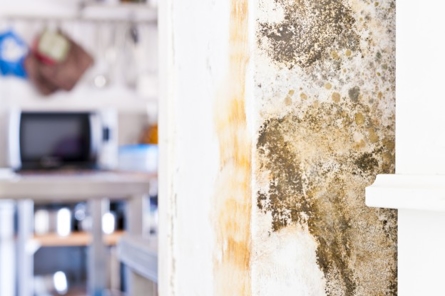
While there are many differences between the two fungi, mold and mildew both develop and thrive in moist conditions. A leaking roof, a window that doesn't seal properly, and a basement with water damage caused by a broken pipe can all lead to the growth of mildew and mold. In order to reduce the risk of illness and damage to building materials, mildew and mold in the home or a business need immediate mold remediation. Continue reading to learn more about the differences between mold and mildew, and the danger both may present to your home or business.
What is Mildew?
Mildew is a form of fungus and is an early-stage mold. Often, the term is used interchangeably with the word mold. That whitish-gray, powdery substance sometimes seen on the leaves of a plant is mildew. Mildew is a surface fungi that grows on organic material like plants and food as well as wood or fibrous items like:
- Drywall
- Insulation
- Cardboard/paperboard
- Wallpaper
- Fabric
Unlike mold, mildew tends to grow just on the surface of something that is wet and can be easily wiped off or removed. Mildew isn’t dangerous on its own, but it is helpful in showing where there is a water leak somewhere in your home.
What is Mold?
Mold ranges in color from green to gray, brownish and black. It may appear fuzzy, flat or even slimy. Green slimy mold may develop in the damp, shady areas of decks and even vinyl siding, while indoors, mold can develop on grout, tile and other surfaces found in and around bathrooms and other areas with high humidity and inadequate ventilation.
Mold is commonly found in areas such as:
- Bathrooms, including sinks, showers, bathtubs, grout, and tiles
- Basements
- Ceilings
- Kitchens
- Outside areas like decks or fences
Mold not only covers the surface of different items, but penetrates them, as well. This can make mold removal difficult and is something that is best left to professionals. Mold is known to cause adverse health effects such as respiratory and neurological issues, eye problems, and circulatory disorders. Mold is a serious problem that needs remediation as soon as possible.
Pro Tip: Slimy mold on decks, fences and siding often can be removed using a pressure washer. Always wear proper safety protection when dealing with mold and working with tools.
What is the Difference Between Mildew and Mold?
The difference between mold and mildew is that mildew is a certain kind of fungus, used generally to refer to flat growth that doesn’t penetrate surfaces. On the other hand, mold encompasses all microscopic fungi and thrive on any organic matter, including clothing, paper, and most areas of your home. Both mold and mildew can also produce a musty smell.
There are some additional differences between mold and mildew, including:
Mold:
- Can cause or exacerbate health problems.
- Penetrates surfaces making it hard to remove.
- Cannot be removed with bleach.
- Has a slimy or fuzzy texture.
Mildew:
- Is usually white, gray, or yellow.
- Has a fluffy or powdery texture.
- Grows on the surface of moist, warm areas.
- Does not penetrate the surface of what it’s growing on.
Mold Remediation is Important For Your Property
Mold and mildew, if ignored, can cause long-term health issues and physical damage to a home or business. Mold found anywhere in a building, such as behind drywall, on insulation, around windows and along basement walls has developed because there is a moisture problem. To avoid further damage, it's essential to locate and correct the source of the moisture and then remove all traces of mold.
Any home or business that's suffered any type of water damage (from firefighting efforts, roof leak, burst pipe or flood) needs professional assessment quickly. If you need mold remediation services for your home or business, contact your nearest ServiceMaster Restore location today or call 1-800-RESPOND.


